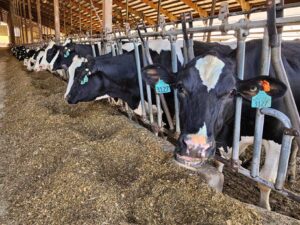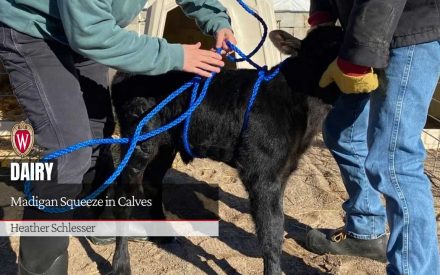
Fiber in the diet provides an important role in rumen function and digestive health. The varying levels of digestibility of fiber are due, in part, to differences in the amount of lignin, the part of the plant cell wall that provides the plant rigidity. Fiber is important for microbial fermentation, which in turn supplies energy to the cow. The primary products of the microbial fermentation of fiber are precursors of fat in milk.
Low fiber and how it leads to disorders & diseases
Dairy cows require certain amounts of effective fiber to properly function. Effective fiber needs to be of adequate length / size to stimulate rumen function without being so long as to be easily sorted out of the ration. Without adequate levels, there isn’t enough fiber to stimulate chewing, promote rumen buffering, properly digest feed, and maintain proper rumen pH levels.
Visual signs of stress from low fiber diets
• Reduction in cud chewing
• Reduction in intake or off-feed
• Decreased rumination time
• Sore or tender feet, stiff gait
• Decreased milk production
• Loose and variable manure
Feeding cows a low fiber diet can cause a handful of metabolic disorders that can affect milk production and the welfare of the animal. Typically, a low fiber diet is considered below 26-28% neutral detergent fiber (NDF). Other factors influencing this minimum NDF value include dry matter intake, forage chop length, starch content & degradability, inclusion of by-product feeds, and feed bunk management. For these reasons, the minimum is a range, rather than a set number. There are many health implications that dairy cows face due to nutritional disorders linked with acidosis.
The pH level in the rumen is a critical indicator of if an animal is getting adequate fiber or getting fiber that is chopped too fine. Feeding forage that is chopped too fine or lacking adequate fiber creates a chain reaction that reduces the chewing time, reducing the amount of saliva that is produced, and in turn causing the rumen pH to drop. As rumen pH drops below 6.2, the microbes that are responsible for fiber digestion decrease activity and fiber digestion decreases while the microbes responsible for digesting starches and sugars increase activity, which drops pH further. If the pH falls below 5.9, digestion of fiber essentially stops.
There are two types of acidosis. Acute acidosis is when the rumen pH drops below 5.0. Subacute rumen acidosis (SARA) is when the pH falls between 5.0 to 5.5 for more than 3 hours. The more common and less severe type is SARA. Maintaining a rumen pH of 6.0 or above is usually beneficial for cow health.
Other disorders associated with low fiber diets
Laminitis
Laminitis is the inflammation of the laminae and corium of the hoof. Laminitis effects can be manifested by a variety of foot disorders. These disorders include: ridges along the foot wall, swelling of the coronary band, flaking and waxy solar horn tissue, false soles, hemorrhage in the sole, white line abscesses, and sole ulcers. These issues have a cost of $90 to $300 per case.
Displaced Abomasum
Displaced Abomasum occurs when the abomasum, which typically lies on the floor of the abdomen, becomes filled with gas and rises to either the left or right side of the abomasum. Even though this disorder is more commonly observed during the transition period, it could occur in mid- and late- lactation cows when diets are not adequate. ($700 per case)
Low butterfat
Low butterfat depressed milkfat varies between breeds of cows. Depressed fat content is at least 0.2% less than breed average. Milk protein butterfat inversions also indicate a depressed fat content.
Liver abscesses
Liver abscesses are sites of bacterial infection within the liver. Most cattle will not show visible signs, although they do not gain weight as well as a healthy animal. The abscesses are typically found during slaughter.
Off-feed
Off-feed when cattle lack the want to eat the feed in front of them which causes decreased rumen fermentation.
Ration considerations for feeding low fiber diets
Fermentable corn products
Dry corn is not as fermentable in the rumen as high moisture corn, flaked corn, or other processed corn sources. We want to avoid highly fermentable corn sources when feeding a low fiber diet. A finer grind on corn products is more acceptable in TMR situations while a coarser grind in component feeding would help with potential overfeeding of starch. Many forage labs can run a grain particle size report on corn products which might be beneficial for your operation.
Particle size / length & mixing consistency
It is important to have a consistent diet being delivered from one end of the feed bunk to the opposite end. It is also important to not overmix your feed as overmixing will break up particle length. On the flip side, it is also important to make sure you do not have too much long particle length in the ration. This can also lead to sorting. Utilizing the Penn State Shaker Box can help determine if you have adequate particle size distribution in the TMR. Proper moisture content is key to help prevent sorting components of the diet. Utilizing liquid products like molasses, whey, or water can help create a less sortable ration.
| Screen | Particle Size inches | Corn Silage % | Haylage % | TMR % |
|---|---|---|---|---|
| Upper | > 0.75 | 3 to 8 | 10 to 20 | 2 to 8 |
| Middle | 0.31 to 0.75 | 45 to 65 | 45 to 75 | 30 to 50 |
| Lower | 0.16 to 0.31 | 20 to 30 | 30 to 40 | 10 to 20 |
| Bottom Pan | < 0.16 | < 10 | < 10 | 30 to 40 |
Rumen buffers
It is recommended to add a buffer to 0.8% of dry matter when feeding low fiber diets. Rumen buffers help to stabilize the rumen pH.
Feed testing
Frequent testing of forages and byproducts being fed to dairy cows will help know what the fiber levels are in the ration being fed.
Feed bunk management
Feed pushups are critical to making sure cows have access to appropriate amounts of fiber. The goal is to avoid long periods without feed in front of the cows because if cows go for long periods without feed in front of them, the next feeding the cows will seek out certain portions of the diet, which can create other management issues. Considerations should also be made on availability of bunk space and how long cows have access to the available bunk space. Producers can utilize the shaker box to check the consistency of the TMR being fed at the beginning, middle and end of feed out.
Summary
While low fiber diets can function if designed correctly, there are risks associated with feeding them without good management practices. Consistent feed testing, paying close attention to cows as they are laying down or walking, watching feed intakes, checking ration particle size, and manure consistency can help detect changes before cows experience a higher risk of metabolic diseases or negative animal performance.
Reviewed by
Matt Lippert
Extension dairy educator for Clark & Wood County
Luiz Ferraretto
Extension Ruminant Nutrition Specialist & Assistant Professor, UW-Madison
References
Animal Health Diagnostic Center. Foot health. Available at: https://www.vet.cornell.edu/animal-health-diagnostic-center/programs/nyschap/modules-documents/foot-health.
Eastridge, M. 2016. Feeding Low Forage Diets to Dairy Cows. Dairy Issue Briefs, Ohio State University Extension. Available at: https://dairy.osu.edu/sites/dairy/files/imce/DIBS/DIBS33-16_Feeding_Low_Forage_Diets_to_Dairy_Cows.pdf.
Eastridge, M. 2007. Guidelines for feeding low forage diets to dairy cows. Ohio Dairy Industry Resources Center, Ohio State University Extension. Available at: https://dairy.osu.edu/newsletter/buckeye-dairy-news/volume-9-issue-3/guidelines-feeding-low-forage-diets-dairy-cows.
Foreman, J.H. 2023. Liver abscesses in cattle. Merck Manual Veterinary Manual. Available at: https://www.merckvetmanual.com/digestive-system/hepatic-disease-in-large-animals/liver-abscesses-in-cattle.
Kröger et al. 2019. Feeding diets moderate in physically effective fibre alters eating and feed sorting patterns without improving ruminal ph, but impaired liver health in dairy cows. Animals, Volume 9, Issue 4: 128. Available at: https://doi.org/10.3390/ani9040128.
Rock River Laboratory, Inc. 2023. 5 ways to optimize a low-forage diet. Michigan Farmer. Available at: https://www.farmprogress.com/feed/5-ways-to-optimize-a-low-forage-diet-for-success.
Salfer et al. 2018. The effects of source and concentration of dietary fiber, starch, and fatty acids on the daily patterns of feed intake, rumination, and rumen pH in dairy cows. J. of Dairy Sci., Volume 101, Issue 12: 10911 – 10921. Available at: https://doi.org/10.3168/jds.2018-15071.
Smith, D.R., P.J. Kononoff, and J.F. Keown. 2007. G1743 dairy cow health and metabolic disease relative to nutritional factors. Available at: https://extensionpublications.unl.edu/assets/html/g1743/build/g1743.htm#:~:text=Vitamins%20A%20and%20D%20and,too%20fat%20or%20too%20thin. Thompson, A. and D. Amaral-Phillis. Preventing milk fat depression in dairy cows. University of Kentucky Cooperative Extension Service. Available at: https://afs.ca.uky.edu/dairy/preventing-milk-fat-depression-dairy-cows.


 Troubleshooting Milk Fat Depression, Key Questions to Ask
Troubleshooting Milk Fat Depression, Key Questions to Ask MILK2024 – Background and Guide
MILK2024 – Background and Guide ▶️ Watch: Confort y diseño de instalaciones en granjas lecheras
▶️ Watch: Confort y diseño de instalaciones en granjas lecheras Madigan Squeeze in Calves
Madigan Squeeze in Calves


